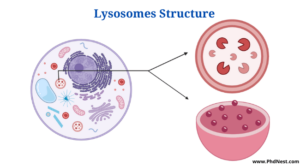Lysosomes Definition
- Lysosomes are dense granular membrane-bound structures that hold hydrolytic enzymes that are largely responsible for intracellular and extracellular digestion.
- The term “lysosome” is made up of two words: “lysis,” which means “breakdown,” and “soma,” which means “body.”
- It’s a crucial cell organelle that breaks down chemicals both within and outside the cell.
- Animal cells are more prevalent, while slime moulds and saprophytic fungi are the only lower plant groups where they may be found.
- Lysosomes are found in abundance in the cytoplasm. In animals, it’s found in practically every cell except RBCs.
- They’re particularly common in cells that participate in enzymatic activities, such as liver cells, pancreas cells, kidney cells, spleen cells, leucocytes, and macrophages.
Lysosomes Structure
- Lysosomes are pleomorphic, meaning they have no distinct shape or structure.
- The majority of them have a spherical or granular look.
- It measures 0.2-0.5 m in diameter and is encased in a single lipoprotein membrane with a distinct makeup.
Created With Bio Render
- Lysosomal associated membrane proteins (LAMP) and Lysosomal integral membrane proteins (LIMP) are heavily glycosylated in the membrane (LIMP).
- LAMPs and LIMPs form a coat on the membrane’s inner surface.
- They shield the membrane from the numerous hydrolytic enzymes that are stored inside.
- A hydrogen proton pump is located on the lysosomal membrane and is responsible for maintaining the enzyme’s pH. The lysosomal enzymes’ functionality is ensured by the acidic media maintained by the proton pump, which pumps H+ into the lumen.
- The organelle contains enzymes in crystalline form inside the membrane.
What is PhD : Meaning, How to Do, Benefits, Full Details
Enzymes of the Lysosome
- Lysosomes, which are loaded with enzymes known as hydrolases, are responsible for the breakdown of extracellular and intracellular materials. It has roughly 40 different enzymes that are divided into the following categories:
- Proteases are proteins-degrading enzymes.
- Lipases are enzymes that help lipids break down.
- Amylase is a digestive enzyme that breaks down carbs.
- Enzymes that break down nucleic acids are known as nucleases.
- Monoesters of phosphoric acid
Hydrolases are a group of enzymes that cause the cleavage of substrates by the addition of water molecules. The majority of lysosomal enzymes work in an acidic environment.
Types of lysosomes are:
Lysosomes are found in a wide range of forms and sizes.
- Primary Lysosomes
- Enzymes generated by the rough endoplasmic reticulum are housed in little sac-like structures.
- Enzyme storage granules are simply referred to as storage granules.
- Secondary Lysosomes
- The merger of primordial lysosomes with phagosomes results in the formation of phagosomes.
- Comprises ingested substances as well as enzymes.
- The materials are gradually absorbed.
Lysosomes Functions
- Lysosomes have two main purposes:
(a) Digestion Within Cells
- The lysosome membrane combines with the food vacuole membrane and squirts the enzymes inside to breakdown food.
- After that, the digested food passes through the vacuole membrane and into the cell, where it is used for energy and development.
(b) Autolytic action
- Autophagy is a process in which vesicles or vacuoles surround cell organelles that need to be ridden, forming an autophagosome.
- Lysosomal enzymes then consume the autophagosome and destroy it.
Lysosomes are involved in a variety of processes, including:
1 . Heterophagy
- Exogenous material is taken into the cell by phagocytosis or pinocytosis, and the ingested material is digested once the newly formed vacuole fuses with a lysosome.
2. Autophagy
- A regular physiological process that involves the body’s cells being destroyed. It is required for maintaining homeostasis, normal functioning via protein breakdown, and the turnover of destroyed cell organelles in preparation for the production of new cells.
3. Digestion Outside the Cell
- Exocytosis allows primary lysosomes to produce hydrolases outside the cell, causing extracellular materials to be destroyed.
- Saprophytic fungus, for example.
4. Autolysis
- The collapse of the lysosomal membrane results in the death of an entire population of cells. It occurs in amphibians and insects throughout their metamorphosis.
5. Fertilization
- Fertilization is a term that refers to the process of fertilising a plant.
- The sperm head’s acrosome is a massive lysosome that ruptures and spills enzymes onto the egg’s surface. By disintegrating the egg membrane, this opens the route for sperm to enter the egg.
6. As the Cell’s Janitors
- Lysosomes help to prevent diseases by removing ‘junk’ that can collect in the cell.
Click Here for Complete Biology Notes
Lysosomes Citations
- Kar,D.K. and halder,S. (2015). Cell biology genetics and molecular biology.Kolkata, New central book agency.
- Rand suwal,S.N. (2010).Human Anatomy and physiology. Kathmandu, vidyarthi prakashan (p.) ltd.
- https://study.com/academy/lesson/lysosome-definition-function-quiz.html
- https://biologydictionary.net/lysosome/
- https://biologywise.com/lysosome-structure
Related Posts
- Phylum Porifera: Classification, Characteristics, Examples
- Dissecting Microscope (Stereo Microscope) Definition, Principle, Uses, Parts
- Epithelial Tissue Vs Connective Tissue: Definition, 16+ Differences, Examples
- 29+ Differences Between Arteries and Veins
- 31+ Differences Between DNA and RNA (DNA vs RNA)
- Eukaryotic Cells: Definition, Parts, Structure, Examples
- Centrifugal Force: Definition, Principle, Formula, Examples
- Asexual Vs Sexual Reproduction: Overview, 18+ Differences, Examples
- Glandular Epithelium: Location, Structure, Functions, Examples
- 25+ Differences between Invertebrates and Vertebrates
- Lineweaver–Burk Plot
- Cilia and Flagella: Definition, Structure, Functions and Diagram
- P-value: Definition, Formula, Table and Calculation
- Nucleosome Model of Chromosome
- Northern Blot: Overview, Principle, Procedure and Results

















